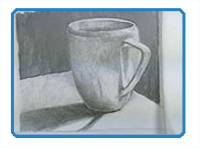
By Matt Fussell
In my opinion, the most important element of art is by far the element - value. Value is the darkness or lightness of a color. Since we make sense of the world around us according to the darks and lights that we see, there's no doubting value's importance in drawing and painting.
Value allows us to understand the forms that we see, and the light that reacts on them. As artists, we must have a strong understanding of value and learn how to use it to create the necessary illusions of light and form in our drawings and paintings.
Value is measured using a value scale...

Darker values are called "shades", while lighter values are termed "tints". Typically, tints are used to create the illusion of highlights, and shades are used to create the illusion of shadows. The placement of highlights and shadows on objects is what leads to the illusion of form and light.
There are several areas of value that often manifest on objects. These are...
1. Highlight - the area on an object where light is hitting.
2. Midtone - the area on an object that is the middle value
3. Core Shadow - the area on the object where light is blocked from hitting the object
4. Reflected Highlight - on rounded objects, the area where light is reflected off of surrounding objects and surfaces to produce a subtle highlight on the object.
5. Cast Shadow - Area on surrounding objects and surfaces where light is prevented from hitting.
Often, in a drawing or painting, if the values are positioned correctly and are close to the reference in their tonality, then the illusion of form and light is achieved.
It is also important to create a full range of value in artworks. This requires making use of each of the values present on a value scale - or at least a broad range of the values. Not only does this help create the illusion that we are after, but it also creates variety and interest in our works.
The following video features excerpts from a 1 hour Live Lesson of a graphite drawing...
Here are some more art lessons that you may like...